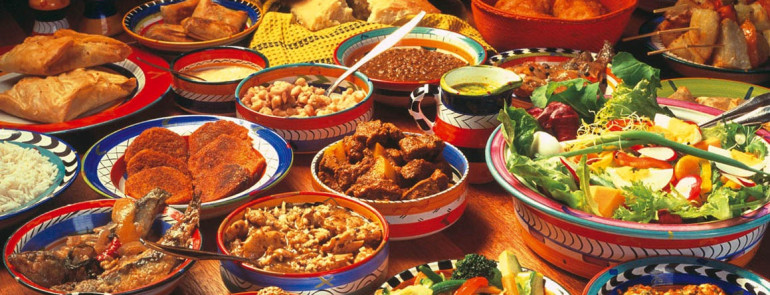If you want to know the culture of a place, dive face-first into their food. Africa is not only a continent of rich and diverse languages and cultures but also home to a tapestry of culinary traditions that are as varied and vibrant as its people. Here food is served communally and we use our hands to feel, scoop, mould, and enjoy it. From the spicy flavors of North Africa to the hearty stews of the West, and the aromatic dishes of the East to the soulful flavors of the South, the continent offers a delightful culinary journey that reflects its history, geography, and the spirit of its people.

Aromas of the Maghreb
The bold flavors and spices of North Africa, characteristic of floral aromas and spicy teas, are largely influenced by the Muslim and Coptic Christians. Morocco, for example, is known for its tagines, which are slow-cooked dishes of tender meat, vegetables, and a blend of spices like cumin, coriander, and saffron. The combination of sweet and savory is a hallmark of Moroccan cuisine, with dishes like chicken with preserved lemons and honey exemplifying this tradition. Algerian cuisine excites the palate with dishes such as couscous, a type of pasta prepared by steaming coarsely ground wheat. And shakshuka, a traditional spicy tomato and egg dish. Meanwhile, Tunisia offers the renowned yummy brik, a deep-fried pastry filled with fish, sometimes eggs, and meat.

Hearty Staples of West Africa
West African meals largely incorporate indigenous vegetables in their meals. Nigeria is the cassava capital of the world. And as such, cassava, along with yam, and plantain, make a pounded dough mix called fufu. You cannot explore West African cuisine without trying jollof rice, a flavorful one-pot rice dish cooked with tomatoes, peppers, and various warm spices like turmeric, nutmeg, and paprika. Nigeria introduces you to dishes like egusi soup, made with melon seeds, and suya, a popular street food of skewered, grilled meat served with spicy peanut sauce. In Ghana, fufu and light soup are staples, where fufu is a starchy accompaniment often served with a flavorful soup. The rich and spicy peanut stew known as groundnut soup is another West African delight.

A Fusion of Spices in East and Central Africa
Aside from ugali, a firm doughy mixture of hot water and maize flour, East Africa also showcases a fusion of Indian, and Arabian influences. The coastal regions of Kenya and Tanzania boast a plethora of Swahili dishes like pilau, and seafood seasoned with coconut milk, spices, and fresh herbs. Injera, a spongy fermented flatbread, really the sourness is not for me, but it is a staple in Ethiopia, Eritrea, and parts of Sudan. It forms the base of any plate and accompanies a variety of spicy stews and lentil dishes.Somali cuisine is known for its delightful use of spices, with dishes like bariis, fragrant spiced rice dish-their pilau equivalent and sambusas, savory pastries filled with meat or vegetables.

Meat, Grains, and Cultural Fusion of the South
Southern African cuisine is a celebration of game meats, maize, and an array of indigenous vegetables. South Africa is renowned for its braai, a barbecue tradition where various types of meat are grilled to perfection. Bobotie, a spiced, baked minced meat dish, is another South African specialty. In Zimbabwe, you’ll find the staple sadza, an ugali equivalent, made from maize, often served with a flavorful stew. Certain as the sun rises from the East, where there are Bantus, there is a maize meal staple. In Botswana, this meal is known as bogobe which accompanies seswaa, a dish of slow-cooked meat until tender and shredded.
Exploring the culinary traditions of Africa is not only a feast for the senses but also a journey into the heart of a rich and varied culture. Whether you’re savoring the complex spices of North Africa, the hearty staples of the West, the fusion of flavors in the East, or the meaty delights of the South, Africa promises a memorable experience that will leave your soul and taste buds craving for more.

